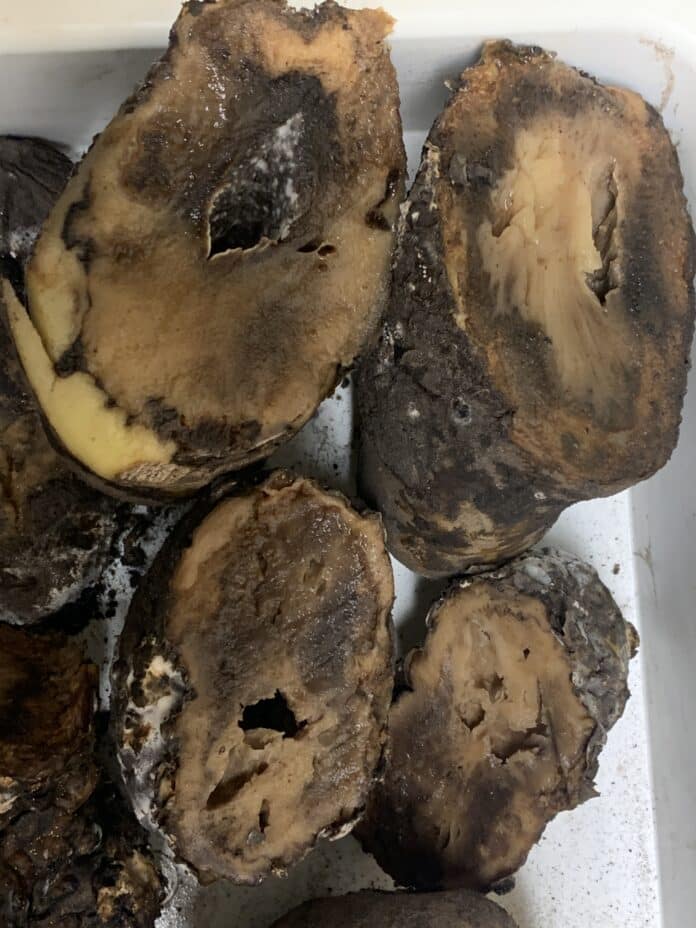A year after rubbery rot made headlines in the U.S., it has been found in Canada.
If there’s one thing Vikram Bisht can remember from 2013, it’s the horrible smell he encountered while visiting a diseased potato storage. The crop had been harvested in 2012 and was oozing a horrible odour that had the potato grower wondering what was going on.
“It was stinking really bad,” Bisht, a plant pathologist for potato and horticultural crops with Manitoba Agriculture, says in a Microsoft Teams interview. “The storage had a really bad stink, and it was basically very wet.”
Bisht collected a sample from the storage, and it was sent to the Manitoba Crop Diagnostic Lab for diagnosis. When the results came back the spuds were found to be infected with the soft rot bacteria, Pectobacterium carotovorum, and several pieces also had a secondary rot, Geotrichum candidum, which causes rubbery rot. It was the first time the disease was reported in Manitoba.
Almost a decade later in 2022, North Dakota State University Plant Pathology Professor Gary Secor discovered rubbery rot in several samples from some Midwestern potato growing states. The only other documented cases of it in North America were in 2018 when the potato and sugar beet pathology lab at the Michigan State University received tubers from a diseased potato storage, and in 2020 at the University of Idaho (U of I) when samples with rubbery rot infection were received.
At the time, there had been no documentation noting the Manitoba detection in 2013. The Manitoba finding was mentioned by Bisht during a presentation Secor gave in early 2023 mentioning his own discovery. Bisht hadn’t previously announced it as he found rubbery rot to be a minor issue to potato growers.
“Many of the potato books for production and diseases don’t even mention robbery rot. Not because it is not known, but because it is of extremely minor importance. But for academics, I think it is something very interesting,” he adds.
Rubbery rot is caused by the pathogen Geotrichum candidum, which is found in soils around the world. Tubers infected with rubbery rot will look wet in appearance and have white tufts of fungal wart-like growths on their skin, and they will exude a sour milk odour. It has been found that rubbery rot is usually a secondary infection to tubers and happens in wetter fields.
Since the disease’s initial discovery in 2020 in Idaho, the university lab has received one to two samples of rubbery rot infected tubers per year, according to James Woodhall, an associate professor and plant pathologist at the U of I.
“I don’t think this is a major disease for Idaho, but it might occasionally cause a problem if the conditions are right for it,” Woodhall stated in an email.
Secor hasn’t encountered rubbery rot since his 2022 detection. In an email he stated his lab hasn’t received any samples from the 2023 crop infected with rubbery rot.
“I think if rubbery rot was present, we would have received some samples,” he said in the email.
In 2019, rubbery rot was diagnosed by the Manitoba Crop Diagnostic Lab in tuber samples from multiple fields.
Bisht himself has encountered rubbery rot again. Rubbery rot was found in a Manitoba potato storage in a crop harvested in fall 2023. The tubers were from a field known to have pink rot infections and tested at the Manitoba Crop Diagnostic Lab with Geotrichum candidum discovered them. During the 2023 growing season, the infected fields experienced high rainfall amounts and warmer temperatures.
“When you have infections happening on the potato and it is starting to rot, then you would see the tuft of fungus growing on it and that is one of the signs that it is possibly also having another fungus growing on too,” Bisht explains, adding that this rubbery rot infection was secondary following the pink rot infection.
While the disease hasn’t caused any major problems, researchers are still on the lookout for it. Most suspect it has been misdiagnosed in the past due to it being a secondary infection.
Related Articles
A New Disease Called Rubbery Rot is Lurking in Potato Storages
Potato Storage Remote Monitoring, Intelligence Platform Launched









